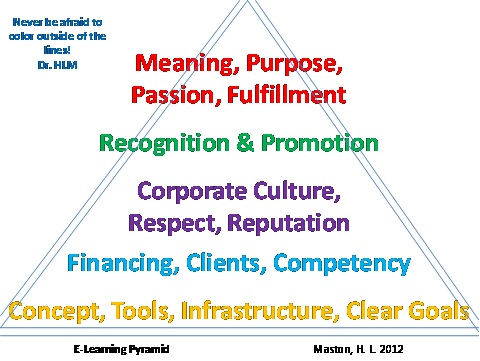Published on
All You Need Is Love! Really? (Part 2)

The feedback I have received surrounding the original article, “All You Need Is Love! Really?” has inspired and propelled me to write more. It appears I have touched a nerve. Onward!
To briefly recap the point of the first installment of this series, “All You Need Is Love! Really?” I’ll simply say, “No. Love is not all you need.”
In fact, love isn’t even in the first two of five tiers. It’s in the middle, a solid half-way point. Love makes us feel good so we aim for that lovin’ feeling. But there is something wrong with that when we start talking about technology and learning. We can’t love our way to success… Somebody has to do the research, lay the plan, and do the work before we get to be giddy. That’s what this e-Learning pyramid is about: The Plan.
Pop culture has long told us that if we simply love something (or someone) enough, love will magically come back to us in spades. We’ll be the owners of all things magical and pure and worthy. We know how well that worked for Romeo and Juliet (not to mention the national divorce rate of +50% (according to divorcerate.com) so I’ll put it out there that the plan of pop culture needs to be revised. Immediately. Because, like it or not, those days are officially over. Hear that chime? Tinker Bell has died. Time to get real.
In Colors of Love (1973), J. A. Lee identified multiple forms of love: eros, ludus, storge, pragma, mania, and agape. Wow! Heavy lifting. I like how Dr. June Klein described love in the comments section of the first installment of this series, “the “dating stage” of love is actually very similar to the brain patterns of typical psychosis! Crazy in love!” That works for me. That shouldn’t be, however, how technology decisions are made. How often does your organization’s “person” (we all have one) bring in the best new thing EVER and is fully convinced that it’s going to cure what ails you? There is a near psychosis associated with that moment, isn’t there? I thought so.
Let that sit for a minute.

Now let’s move on to using the e-Learning Pyramid without the cloud of the love psychosis. But first a visual refresher on Maslow’s Hierarchy of Needs (1943).
I’m a pragmatic woman. I like lists. I like plans. Give me a workable chart and you can skip the diamonds (almost). Here’s how this hierarchy pyramid works for me and might work for you.
To quote the original article, “Now, what would happen if Maslow’s Hierarchy were tweaked to reflect the necessities of e-Learning? I would imagine it would look something like this:
Five Levels of e-Learning Pyramid (Maston, H. 2012)
- Concept, Tools, Infrastructure, Clear Goals: Physiological needs
- Financing, Clients, Competency: Security needs
- Corporate Culture, Respect, Reputation: Social needs
- Recognition, Promotion: Esteem needs
- Meaning, Purpose, Passion, Fulfillment: Self-Actualizing needs.”
What is meant by the individual components of the specific layers? Glad you asked!
1. Concept: This is where the BIG questions are asked: What are we doing? Who is our audience? Should it be done? Can we do this? Why us? Unfortunately it’s also the step that a lot of organizations skip because they’re so in love with the idea of the technology that they haven’t formulated a tangible foundation in their collective heads. Tools: This is a very pragmatic question and basically means: Do we have the stuff to make the other stuff work? Stuff is defined as both the hard, and soft, tools. Pay special attention here as the answer is often, “I don’t know” or “No.” Infrastructure: This question reflects back to “Tools”. If we don’t have the stuff to make the other stuff (Tools) work, can we get it? What will it cost? Who will be in charge? Who will maintain? Who will upgrade? Without a “Keeper of the Stuff”, the technology won’t soon matter. Clear Goals: Time to make a list of the above: concept, tools, infrastructure and fill in those blanks. Make your foundation however you want to build it but make sure it’s solid, supported, and built to weather a storm (or several) because you just never know. Be prepared.
2. Financing: This one isn’t difficult to talk about but it is a bit of a challenge to gather. Unless you have a plan (see above). Do you have the money to do this? Where is that money coming from? Is it reliable? Is it steady? Is it legal? Giggle if you must but I’ve seen many a business go forward without all of these questions being answered, “YES!” I’m sure you have, too. Don’t be that guy. Clients: Communications class 101: Know your audience. Who are they? What do they want? Where are they located and accessed? When will they come to (and pay) you? Why should clients come. Competency: This bounces back on the above: financing and clients. Can you get it (financing) to get them (clients)? Who in your organization is trusted with this task? Are they capable of doing the job? Are you? Ask the question and be open to all answers. Remember, nothing is permanent but chosen apathy based in fear.
3. Corporate Culture: Now that there is a clear plan, it’s time to have a love-fest! Are you in love with your goals? Are you in love with your chosen direction? Are you in love with your co-worker? (Skip that. TMI) This is where the culture of your organization can either breed fear or breed joy. Either of those climates is based almost entirely on the recognition and fulfillment of the above stages and components. You plan, you choose. Respect: In this stage, love comes back to you. You’ve done your due diligence and it’s paying off in the form of admiration of peers, clients, vendors, and profit. You can bask in the glow, it’s ok. You worked for it and you deserve it. Bask. Reputation: A funny thing happens when the love and respect needs are met your organization (and you) develops a great reputation. Suddenly everybody wants to be your friend, clients come through the door, learners learn, and you get invited to all the ‘cool-kid’ parties. You are loved.
4. Recognition: When you are loved your esteem skyrockets. Suddenly you are invincible and are willing and able to take greater risks which often lead right back to greater rewards. You have built a solid foundation, kept your wits about you, and the sky is the limit. Promotion: People want to be around successful and happy people. It’s catchy. There is a reason that the “Debbie Downer” character on Saturday Night Live is so popular – no one wants to be that person but so many are. Let your good love feelings shine through and you will be promoted to the land of other happy and successful individuals.
5. Meaning: As individuals in a company grow, they often change their worldview. They seek greater meaning for their actions. How to give back? How to donate to the greater good? This is good for both the organization as well as the individuals involved. It provides direction for the next set of implementation choices. How can we be more useful to more people? Purpose: This is the individual question. A question that follows “meaning” in that it addresses the individual involved in the process and pre-dates “passion” by clearly setting its stage. Why am I here? Passion: A single question to be asked: What keeps you up at night? Answer that and you have your passion. Fulfillment: When seeking this final apex keep in mind the answers to everything below. You are your own cherry on your sundae.
So, much like adolescents who are experiencing love-type relationships for the first time, and completely giddy with the chemical endorphins that come with the new exciting experience, so are the feelings that are triggered by the newest, latest greatest technologies available in a field where there is not a long list of tangible prior experiences to guide their way. Everyone seems to be going it alone (or at the very most, in small groups with randomly comprised lists of “Best Practices”).
While the pyramid, and elaborations, above were written for the e-Learning technology field, it could apply in nearly every venue. The open ends of the pyramid are strategically placed to remind the user that each organization is unique, and therefore the flow might be a little different, but that the structure is consistent in its development. The steps are practical, easy, concise and not terribly complicated to implement. They identify the love reaction to the new shiny thing and address why that is a no-win situation if that is the initial driving force. Love matters – just later.
Many steps. Many paths. Many outcomes. Successful ones all begin with a solid foundation. Build one.
Peace and good choices.
PS: YES, I modified the name of the Pyramid from the original article. Keeping my ducks in a row.
For Part 1, see All You Need Is Love! Really?
Author Perspective: Business



